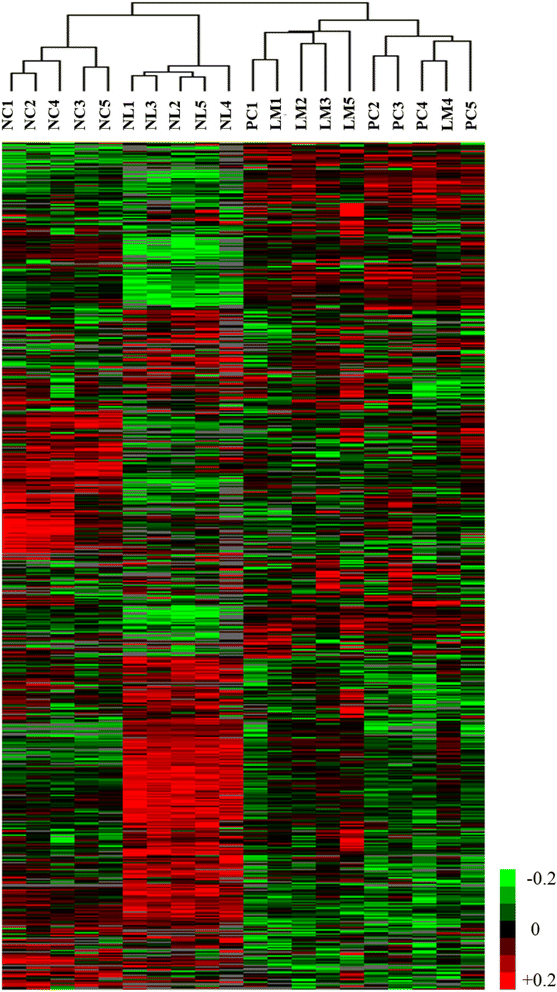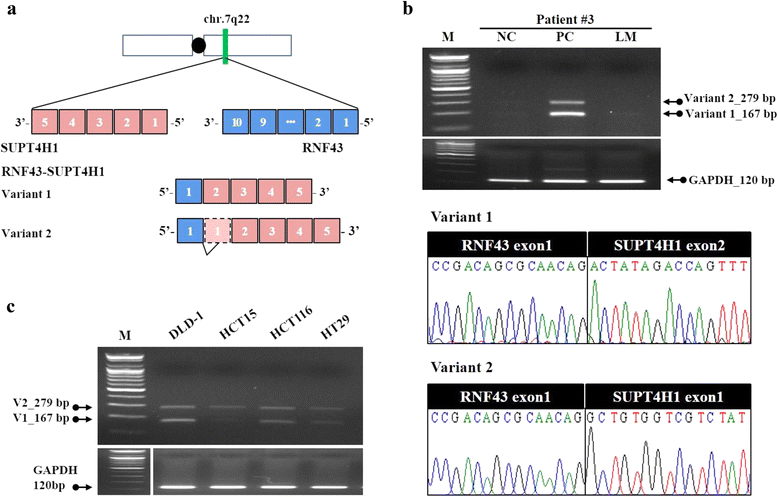Transcriptome analysis of paired primary colorectal carcinoma and liver metastases reveals fusion transcripts and similar gene expression profiles in primary carcinoma and liver metastases
- PMID: 27461012
- PMCID: PMC4962348
- DOI: 10.1186/s12885-016-2596-3
Transcriptome analysis of paired primary colorectal carcinoma and liver metastases reveals fusion transcripts and similar gene expression profiles in primary carcinoma and liver metastases
Abstract
Background: Despite the clinical significance of liver metastases, the difference between molecular and cellular changes in primary colorectal cancers (CRC) and matched liver metastases is poorly understood.
Methods: In order to compare gene expression patterns and identify fusion genes in these two types of tumors, we performed high-throughput transcriptome sequencing of five sets of quadruple-matched tissues (primary CRC, liver metastases, normal colon, and liver).
Results: The gene expression patterns in normal colon and liver were successfully distinguished from those in CRCs; however, RNA sequencing revealed that the gene expression between primary CRCs and their matched liver metastases is highly similar. We identified 1895 genes that were differentially expressed in the primary carcinoma and liver metastases, than that in the normal colon tissues. A major proportion of the transcripts, identified by gene expression profiling as significantly enriched in the primary carcinoma and metastases, belonged to gene ontology categories involved in the cell cycle, mitosis, and cell division. Furthermore, we identified gene fusion events in primary carcinoma and metastases, and the fusion transcripts were experimentally confirmed. Among these, a chimeric transcript resulting from the fusion of RNF43 and SUPT4H1 was found to occur frequently in primary colorectal carcinoma. In addition, knockdown of the expression of this RNF43-SUPT4H1 chimeric transcript was found to have a growth-inhibitory effect in colorectal cancer cells.
Conclusions: The present study reports a high concordance of gene expression in the primary carcinoma and liver metastases, and reveals potential new targets, such as fusion genes, against primary and metastatic colorectal carcinoma.
Keywords: Colorectal cancer; Expression profiling; Gene fusion; RNA-seq.
Figures




Similar articles
-
Comparative analysis of primary tumour and matched metastases in colorectal cancer patients: evaluation of concordance between genomic and transcriptional profiles.Eur J Cancer. 2015 May;51(7):791-9. doi: 10.1016/j.ejca.2015.02.012. Epub 2015 Mar 18. Eur J Cancer. 2015. PMID: 25797355
-
Transcriptome analysis in primary colorectal cancer tissues from patients with and without liver metastases using next-generation sequencing.Cancer Med. 2017 Aug;6(8):1976-1987. doi: 10.1002/cam4.1147. Epub 2017 Jul 26. Cancer Med. 2017. PMID: 28745433 Free PMC article.
-
Impact of microRNAs on regulatory networks and pathways in human colorectal carcinogenesis and development of metastasis.BMC Genomics. 2013 Aug 29;14:589. doi: 10.1186/1471-2164-14-589. BMC Genomics. 2013. PMID: 23987127 Free PMC article.
-
Is there a genetic signature for liver metastasis in colorectal cancer?World J Gastroenterol. 2007 Nov 28;13(44):5832-44. doi: 10.3748/wjg.v13.i44.5832. World J Gastroenterol. 2007. PMID: 17990349 Free PMC article. Review.
-
Genomic profiling of sporadic liver metastatic colorectal cancer.Semin Cancer Biol. 2021 Jun;71:98-108. doi: 10.1016/j.semcancer.2020.05.013. Epub 2020 May 30. Semin Cancer Biol. 2021. PMID: 32485312 Review.
Cited by
-
Distinguishing Rectal Cancer from Colon Cancer Based on the Support Vector Machine Method and RNA-sequencing Data.Curr Med Sci. 2021 Apr;41(2):368-374. doi: 10.1007/s11596-021-2356-8. Epub 2021 Apr 20. Curr Med Sci. 2021. PMID: 33877555
-
Identifying common transcriptome signatures of cancer by interpreting deep learning models.Genome Biol. 2022 May 17;23(1):117. doi: 10.1186/s13059-022-02681-3. Genome Biol. 2022. PMID: 35581644 Free PMC article.
-
A novel isoform of IL-33 revealed by screening for transposable element promoted genes in human colorectal cancer.PLoS One. 2017 Jul 17;12(7):e0180659. doi: 10.1371/journal.pone.0180659. eCollection 2017. PLoS One. 2017. PMID: 28715472 Free PMC article.
-
The fusion gene hsf5-rnf43 in Nile tilapia: A potential regulator in the maintenance of testis function and sexual differentiation.iScience. 2023 Oct 21;26(11):108284. doi: 10.1016/j.isci.2023.108284. eCollection 2023 Nov 17. iScience. 2023. PMID: 38026183 Free PMC article.
-
Bioinformatics Analysis of RNA-seq Data Reveals Genes Related to Cancer Stem Cells in Colorectal Cancerogenesis.Int J Mol Sci. 2022 Oct 31;23(21):13252. doi: 10.3390/ijms232113252. Int J Mol Sci. 2022. PMID: 36362041 Free PMC article.
References
MeSH terms
Substances
LinkOut - more resources
Full Text Sources
Other Literature Sources
Medical

